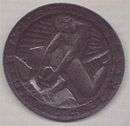Hinko Juhn
Hinko Juhn (1891–1940) was a Yugoslav sculptor, best known for his ceramics. He studied at the Arts & Crafts College in Zagreb and the International Academy in Florence, and took specialist classes in ceramics in the Czech Republic, Germany and at the Vienna School of Applied Arts. On his return to Zagreb, he exhibited his work at the Spring Salon and introduced ceramic techniques to a new generation of Yugoslav artists through his teaching.
Hinko Juhn | |
|---|---|
 | |
| Born | 9 June 1891 |
| Died | 5 September 1940 (aged 49) |
| Education | Zagreb, Vienna |
| Known for | sculpture, ceramics |
| Movement | art deco |
Biography

Juhn was born on June 9, 1891 in Podgorač near Našice to a Jewish family.[1][2][3] After two years at the high school in Osijek, at the age of 13 he enrolled in the State Craft School in Zagreb.[3] In 1907 he went on to study sculpture at the College of Arts and Crafts in Zagreb under Robert Frangeš-Mihanović and Rudolf Valdec, graduating in 1911.[4] He continued his studies at the International Academy in Florence, where he also held his first solo exhibition in 1912.[3]
Juhn was one of the founders in 1916 of the Zagreb Spring Salon,[3] where he continued to exhibit his works until 1928.[5] He started working in ceramics, and became interested in learning more. In 1918, therefore, he went to the Czech Republic, where he studied at a specialist ceramics school in Bechyne, then at the State School of Crafts in ceramics and applied arts in Teplice Drevodan.[3] He spent some time in Dresden at the Meissen porcelain works,[3] then continued his ceramic studies at the Vienna School of Applied Art.[6]
Returning to Zagreb in 1921, Juhn established a ceramics department at the College of Arts and Crafts. In 1924, he transferred to the State Craft School, where he was professor of ceramics for the rest of his life.[3]
Hinko Juhn died in Zagreb on 5 September 1940.
Legacy
Although Hinko Juhn created sculptural works in many different kinds of media, he is best known for his ceramics. He was the first Croatian sculptor to specialize in that medium, and he is responsible for the popularity of the medium in Croatia between the two world wars.[7]
Juhn was a master of miniature sculptures, mostly female nudes, in a variety of materials such as plaster, bronze and terracotta, as well as ceramics. He also created works of applied art, such as bowls, vases and candlesticks, and larger works such as sculptural reliefs for indoor public spaces.[6][8]
For the 1929 World Expo in Barcelona, Juhn worked with Blanka Dužanec to create a ceramic frieze. He collaborated with architects Baranyai and Benedik on interior decoration designs.[6]
Street and the Hinko Juhn Elementary School in Pogorac is named after its most famous former pupil.[9][8]
Exhibitions
Juhn exhibited frequently at home and abroad, especially at the Spring Salon in Zagreb, with the artist Society "Work" and at the international exhibition of contemporary decorative arts in Paris.[8]
Group exhibitions
Recent exhibitions that have included works by Hinko Juhn:
- 2011 Art Deco in Croatian Art between the two world wars, Museum of Arts and Crafts, Zagreb[7]
Public collections
Hinko Juhn's work can be found in the following public collections in Croatia:
References
- Snješka Knežević (2011, p. 92)
- (in Croatian) Ha-Kol (Glasilo Židovske zajednice u Hrvatskoj); Nataša Maksimović Subašić; Hinko Juhn - umjetnik, kipar i keramičar; stranica 24, 25; broj 110, lipanj / srpanj / kolovoz 2010.
- "Hinko Juhn". Artist Biography. Galerija Divila. Archived from the original on 17 February 2013. Retrieved 11 March 2012.
- Juhn, Hinko, Hrvatski Leksikon (in Croatian), I, Zagreb: Naklada Leksikon d.o.o., 1995, p. 552, ISBN 953-96728-1-3
- "The collection of Croatian sculpture from the 19th to the 21st century (Croatian Academy Glyptotheque)". Collection. Croatian Cultural Heritage. Retrieved 11 March 2012.
- "Hinko Juhn's Memorial Room". Nasice Native Museum. MDC: Museum Documentation Center. Archived from the original on 4 March 2016. Retrieved 11 March 2012.
- "Art Deco in Croatian Art between the two world wars". Exhibitions (in Croatian). Museum of Arts and Crafts, Zagreb. Retrieved 11 March 2012.
- "Hinko Juhn". Osnovna škola Hinka Juhna Podgorač. Retrieved 11 March 2012.
- (in Croatian) Ha-Kol (Glasilo Židovske zajednice u Hrvatskoj); Nataša Maksimović Subašić; Zora Dirnbach – Svjetionik s one strane nacionalizma; stranica 25; broj 110, lipanj / srpanj / kolovoz 2009.
- "Sculpture Collection". Collection. Museum of Modern and Contemporary Art, Rijeka. Retrieved 11 March 2012.
Bibliography
- Snješka Knežević, Aleksander Laslo (2011). Židovski Zagreb. Zagreb: AGM, Židovska općina Zagreb. ISBN 978-953-174-393-8.CS1 maint: ref=harv (link)